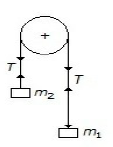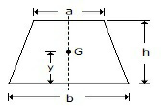The energy possessed by a body, for doing work by virtue of its position, is called
Potential energy
Kinetic energy
Electrical energy
Chemical energy
Correct Answer :
A. Potential energy
Related Questions
A smooth cylinder lying on a __________ is in neutral equilibrium.
Curved surface
Convex surface
Horizontal surface
None of these
When trying to turn a key into a lock, following is applied
Coplanar force
Non-coplanar forces
Moment
Couple
Which of the following is not the unit of pressure?
kg/cm
Bar
Atmosphere
Newton
Which one of the following statements is not correct?
The tangent of the angle of friction is equal to coefficient of friction
The angle of repose is equal to angle of friction
The tangent of the angle of repose is equal to coefficient of friction
The sine of the angle of repose is equal to coefficient to friction
The force, by which the body is attracted, towards the centre of the earth, is called
Impulsive force
Mass
Weight
Momentum
The coefficient of restitution for inelastic bodies is
Zero
One
Between zero and one
More than one
The units of moment of inertia of an area are
kg-m²
m⁴
kg/m²
m³
In order to completely specify angular displacement by a vector, it must fix
Direction of the axis of rotation
Magnitude of angular displacement
Sense of angular displacement
All of these
The three forces of 100 N, 200 N and 300 N have their lines of action parallel to each other but act in the opposite directions. These forces are known as
Coplanar concurrent forces
Coplanar non-concurrent forces
Like parallel forces
Unlike parallel forces
The friction experienced by a body, when in motion, is known as
Rolling friction
Dynamic friction
Limiting friction
Static friction
A force while acting on a body may
Change its motion
Balance the forces, already acting on it
Give rise to the internal stresses in it
All of these
Static friction is always __________ dynamic friction.
Equal to
Less than
Greater than
None of these
The linear acceleration (a) of a body rotating along a circular path of radius (r) with an angular acceleration of α rad/s2, is
a = α/ r
a = α.r
a = r / α
None of these
The maximum height of a projectile on a horizontal plane, is
u² sin²α/2g
u² cos²α/2g
u² sin²α/g
u² cos²α/g
The forces, whose lines of action are parallel to each other and act in the same directions, are known as
Coplanar concurrent forces
Coplanar non-concurrent forces
Like parallel forces
Unlike parallel forces
The moment of inertia of a square of side (a) about an axis through its centre of gravity is
a4/4
a4/8
a4/12
a4/36
The moment of inertia of a thin disc of mass m and radius r, about an axis through its centre of gravity and perpendicular to the plane of the disc is
mr2/2
mr2/4
mr2/6
mr2/8
Whenever a force acts on a body and the body undergoes a displacement, then
Work is said to be done
Power is being transmitted
Body has kinetic energy of translation
None of these
The rate of doing work is known as
Potential energy
Kinetic energy
Power
None of these
The velocity ratio for the first system of pulleys is (where n is the number of pulleys.)
n
n²
2n
2n - 1
The periodic time of one oscillation for a simple pendulum is (where l = Length of the pendulum.)
(1/2π). √(l/g)
(1/2π). √(g/l)
2π. √(l/g)
None of these
Moment of inertia of a rectangular section having width (b) and depth (d) about an axis passing through its C.G. and parallel to the depth (d), is
db3/12
bd³/12
db³/36
bd³/36
If the masses of both the bodies, as shown in the below figure, are doubled, then the acceleration in the string will be 
Same
Half
Double
None of these
The moment of inertia of a solid cylinder of mass m, radius r and length l about the longitudinal axis or polar axis is
mr2/2
mr2/4
mr2/6
mr2/8
Two non-collinear parallel equal forces acting in opposite direction
Balance each other
Constitute a moment
Constitute a couple
Constitute a moment of couple
The centre of gravity of a trapezium with parallel sides a and b lies at a distance of y from the base b, as shown in the below figure. The value of y is 
h [(2a + b)/(a + b)]
(h/2) [(2a + b)/(a + b)]
(h/3) [(2a + b)/(a + b)]
(h/3) [(a + b)/(2a + b)]
The centre of gravity of a quadrant of a circle lies along its central radius (r) at a distance of
0.5r
0.6 r
0.7 r
0.8 r
In actual machines
Mechanical advantage is greater than velocity ratio
Mechanical advantage is equal to velocity ratio
Mechanical advantage is less than velocity ratio
Mechanical advantage is unity
If three forces acting in different planes can be represented by a triangle, these will be in
Non-equilibrium
Partial equilibrium
Full equilibrium
Unpredictable
Moment of inertia of a triangular section of base (b) and height (h) about an axis passing through its C.G. and parallel to the base, is
bh3/4
bh3/8
bh3/12
bh3/36
